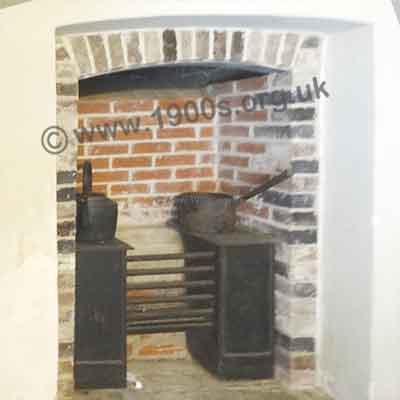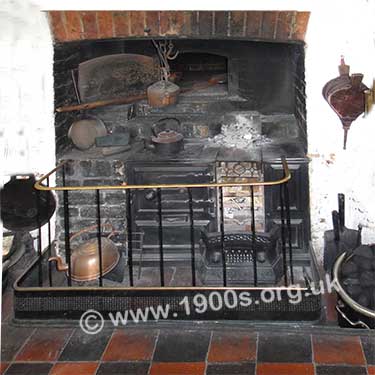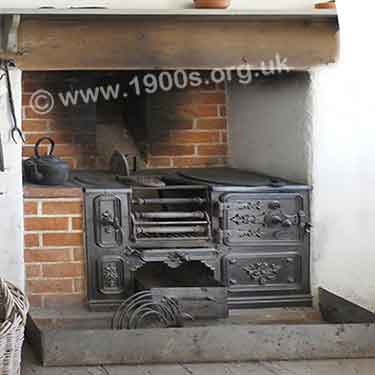The kitchen fire in Victorian and Edwardian times
As explained on other pages, the kitchen was where families used to live and work, and the scullery was where the main cooking took place. Yet some small-scale cooking did take place in the kitchen on a kitchen fire which doubled as a welcoming warming fire and a mini version of a kitchen range. This page elaborates. It is written from firsthand experience and is well-illustrated.
____
By the webmaster's mother (1906-2002) from firsthand observations, edited with further research by the webmaster
Purpose of the kitchen fire
The purpose of the kitchen fire in Victorian and Edwardian times was two-fold: to provide warmth as the living area for the family and to provide limited cooking facilities. The kitchen needed a fire because that was where the family spent its time, but it was not the sort of fire that you would recognise today. To save the time and money which would be involved in heating the large range in the scullery, the kitchen fire had very small ovens and hot plates adjacent to and heated by the actual fire in the centre. There were numerous versions. The one shown below has two ovens and hotplates.
Cooking on the kitchen fire

The basic arrangement of a Victorian style cast-iron kitchen fire with its limited cooking facilities
The ovens enabled cooking meals that required long, slow cooking, such as meat stews and rice puddings, and the hotplates enabled kettles to be boiled and saucepans to be heated. Many a tasty meal has come out of such ovens and they were well-used.
So you can see that some cooking did take place on the kitchen fire which doubled as a welcoming heater for the room. It was kept burning in all but the hottest of summers. Then it was replaced by a primus stove for boiling the kettle or a saucepan.
In fact the full-size kitchen range in the scullery was seldom lit for small families. However it was common for many families to have nine or ten children and they would have had to use their larger range.
Coal and oil were our only forms of heating.
Essential parts of the kitchen fire
The above photo showed the basic arrangement with the emphasis on basic. Once you understand it, you are in a good position to look at the following photos which give a fuller picture of the variety and accessories of kitchen fires.

Note in particular the heavy fitted fireguard - also written as the two words fire guard -, the incorporated bread oven in the back wall and the bellows to start the fire.

Also note the heavy fitted kerb round the fire, and the ash collection tray which is open. The dark patch at the back could be a bread oven but it is too dark to be sure.
All kitchen fires had a flat surface for use when ironing clothes. The irons on it would face the bars to heat up. In the first photo it can't be seen because it is closed with a door while not in use. In the second photo it is pulled down for use, and visible if you look closely.
In practice, a fitted kerb and fireguard would be present for all kitchen fires, but parts get lost before items can be collected by museums, that being where these photos were taken.
Kitchen fires had an excellent safety record because the high metal fireguard was always in place unless cooking or attending to the ovens.
The work involved with a kitchen fire
There was always a lot of work with the kitchen fire, but there was no alternative. My mother kept our kitchen fire beautifully clean with black lead - a polish for cleaning and polishing cast iron. The outer rims were steel and were always kept bright with emery paper. The fact that these rims are not obviously shiny in the photos is almost certainly because no-one now cleans them.
Similar work was involved in cleaning the larger kitchen ranges, but they were not used as often as the smaller fires. The work of kitchen maids in the large wealthier houses where ranges were used as a norm must have been debilitating.
Cleaning the ashes from kitchen fires and the larger ranges is described on the page on coal fires.
The smell of a kitchen fire
One smell associated with the kitchen fire was that of cooking, but there was another which was far from pleasant. This smell was of wet outdoor clothes being hung over the fireguard to dry. (The fireguard was substantial enough to take the clothes, as explained in the page on drying washing on wet washdays.)
In those days there were no such things as mackintoshes and if it rained hard on our way home from school at dinnertime (lunchtime), we really had a soaking. So our coats had to be dried quickly for us to get back to school by 2 o'clock.
The smell that came from these wet clothes was quite revolting. There were no dry-cleaners and no man-made fabrics, and the clothes had been about for years, having been passed down from one set of children to another. Woollen clothes were seldom if ever washed because wool always shrunk, often unevenly, making the clothes too misshapen for use. Dirty marks were merely sponged off.
It's strange how some smells affect us. They seem to disgust and yet fascinate. African marigolds have the effect on me, as do moth balls.
| sources | webmaster | contact |
Text and images are copyright
If you can add anything to this page or provide a photo, please contact me.



